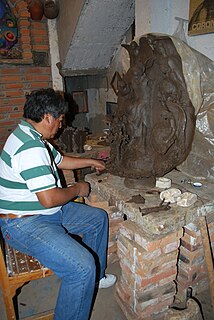
The Soteno family of Metepec is one of the main families of ceramic artisans specializing in sculptures called Trees of Life which have made the town found in the State of Mexico one of Mexico’s main ceramic centers. The Tree of Life is a complicated colorful sculpture which was developed from the creation of candlesticks. The family’s prominence began with Modesta Fernández Mata, the mother, grandmother and great-grandmother of the Soteno potters today, who began experimenting making more decorative items along with utilitarian ones. The generations after her have learned the craft and improved on it starting as children working with parents and grandparents. The two most notable members of the family are Tiburcio and Oscar, second and third generation respectively, who have won various awards and have their works in collections worldwide.
Esther Medina Hernández is a Mexican potter, known for her barrel cactus shaped wares.
Maximo Gómez Ponce is a noted Mexican potter from the La Luz neighborhood of the city of Puebla, an area known for its local traditional pottery.

Hilario Alejos Madrigal is a Mexican potter from a small town in the state of Michoacán, known for his “pineapple” ceramic wares. The name comes from the original form created by his mother, potter Elisa Madrigal Martinez, who created punch bowls in the shape of pineapples. Alejos Madriga’s variations include bowls, candelabras and more, with the version done in a green glaze be best known. Alejos Madrigal has won awards for his work, which is featured on the cover of large reference book Grandes Maestros del Arte Popular Mexicano by Fomento Cultural Banamex.
Cesar Torres Ramírez is a Mexican potter who specialized in the country Talavera pottery tradition. His work has been featured in books such as Cerámica Y Cultura: The Story of Spanish and Mexican Mayólica of the Museum of International Folk Art in New Mexico, in the Grandes Maestros de Arte Popular Mexicano as a “grand master” by the Fomento Cultural Banamex and as one of Mexico’s best artisans in a documentary on Canal Once in Mexico.
Pedro Ruiz Martínez and Odilia Pineda are husband and wife Mexican potters, who work in Capula, Michoacán. This town is noted for its ceramics distinguished by having its designs painted on with small dots in a technique called “punteaje.”
Neftalí Ayungua Suárez is a Mexican potter from Patamban, Michoacán, named a “grand master” of Mexican folk art.
Celso Camacho Quiroz is a fourth-generation Mexican potter who works in Metepec, in the State of Mexico. His specialty is the making of large cooking vessels called “cazuelas,” traditionally used to cook mole and rice, but he also makes a number of other utilitarian and decorative pieces. His work has been recognized with awards such as the Gran Premio de Arte Popoular from FONART in 1999 and being named a “grand master” by the Fomento Cultural Banamex in 2003.
Miguel Chan and Roger Juárez are Mexican potters, partners in producing Mayan culture-inspired pottery in Ticul, in the state of Yucatán. Ticul, along with Mama and Maxcanú are traditional pottery centers for the state, where pieces are made using a k´abal, a rudimentary form of pottery wheel. The pieces are decorated using implements that they make themselves from branches, leather, gourds and feathers.

Apolinar Hernandez Balcazar is a Mexican basket maker from San Martin Coapaxton, Tenancingo, State of Mexico, whose work has won various national awards.
Felipa Tzeek Naal is a Mexican artisan specializing in traditional Maya palm frond weaving. Her work is well-known regionally and has been recognized by the Fomento Cultural Banamex, who named her a "grand master".
Andrés Uc Dzul (1910–2004) was a Mexican artisan specializing in the creation of palm hats, especially Panama hats. His work was in great demand in the first half of the 20th century, and he was later recognized as a “grand master”.

Fortunato Moreno Reinoso is a Mexican artisan from Ixmiquilpan, Hidalgo in central Mexico. He is noted for his work in reeds and bamboo, a tradition from the Otomi group to which he belongs, learning it from his father and grandfathers.
The Pineda Palacios is a Mexican family of artisans which specializes in the making of nativity scenes with figures made from palm fronds. Their work has been recognized by being named “grand masters” of Mexican handcrafts by the Fomento Cultural Banamex.
The Aguirre family is a Mexican artisan family specializing in inlaid wood items. Two of the family members, Silvano and Francisco, have been named "grand masters" of Mexican folk art by the Fomento Cultural Banamex.
Hipolito Vázquez Sánchez is a Mexican woodcarver from San Esteban Tizatlán, Tlaxcala in central Mexico. His work has earned him numerous awards and recognitions, including being named a “grand master” by the Fomento Cultural Banamex.

Manuel Jiménez Ramírez was a Mexican carver, sculptor and painter credited as the originator of the Oaxacan version of “alebrijes,” animal creatures carved in wood and painted in strong contrasting colors with intricate designs. He was a charismatic and philosophical person, who believed he was the reincarnation of an artist. He began making animal figures of clay when he was a child but changed to wood carving later, creating human figures, nativity scenes, masks and more as well as the alebrijes. He work can be found in public and private collections in various parts of the world, especially in the United States.
José Reyes Juárez is a Mexican mask masker for traditional dances in the state of Tlaxcala. His work has earned him the title of “grand master” from the Fomento Cultural Banamex.
The Plácido Otilia family is a Mexican family which specializes in the making of traditional musical instruments for the Huapango music of the La Huasteca region.(grandes) The family lives in Texquitote, Matlapa, San Luis Potosí and headed by patriarch Eustacio Plácido Otilia, an ethnic Nahua.





